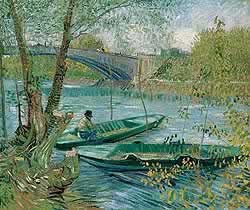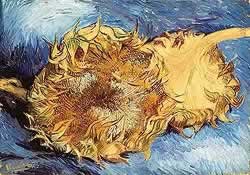
|
PARIS
In the spring of 1886, van Gogh left Antwerp for Paris, where he lived with his brother Theo, an art dealer, and embarked upon an intense period of study to absorb the chromatic and stylistic lessons of Impressionism and Neo-Impressionism. Gauguin, who declined to emulate his Impressionist master Camille Pissarro, tried to strike new ground, first by exploring the medium of ceramics and then by venturing to the distant Caribbean territory of Martinique. The pictures Gauguin produced on this tropical island greatly impressed the van Gogh brothers, who saw them in Paris in the fall of 1887. Van Gogh and Gauguin’s initial meeting was indeed revelatory for both men.
In Gauguin, van Gogh saw an individual capable of producing an "art of the future," which would speak to modern society. Gauguin, however, viewed the van Gogh brothers as a valuable connection to the art market. The two artists subsequently exchanged paintings: van Gogh sent two studies of sunflowers, including Two Sunflowers (1887), in exchange for Gauguin’s On the Shore of the Lake, Martinique (Negresses) (1887). This exchange solidified their friendship and set into motion the correspondence that would eventually lead to the creation of the Studio of the South in Arles, France.

The broken brushstrokes of bright spring colors as well as the choice of subject—a view of the Seine on the outskirts of Paris—mark the influence of Impressionism on van Gogh following his move to Paris. Although this painting resembles a composition by Claude Monet, the calculated and structured application reveals van Gogh's attraction to the Neo-Impressionist style of Georges Seurat, who had painted fishermen in the same location several years earlier.

Two Sunflowers, one of two canvases van Gogh presented to Gauguin shortly after their first meeting in Paris, depicts a subject that would come to symbolize van Gogh's hope for the renewal of French painting. The two cut blooms burst forth in this intensely colored, monumental, energetic canvas, one of Van Gogh's numerous depictions of his favorite flower, whose multiple associations ranged from the religious (faith and devotion to God) to the aesthetic (ideal beauty).
Van Gogh and Gauguin: The Studio of the South has been organized by The Art Institute of Chicago and the Van Gogh Museum, Amsterdam. This exhibition is supported by an indemnity from the Federal Council on the Arts and the Humanities.
Van Gogh and Gauguin: The Studio of the South is part of the "Ameritech Exhibition Series" made possible through a grant from the Ameritech Foundation.
|








